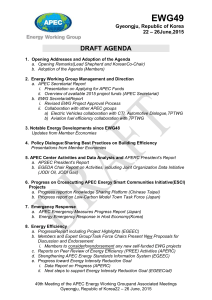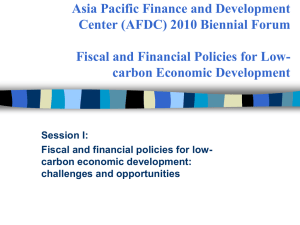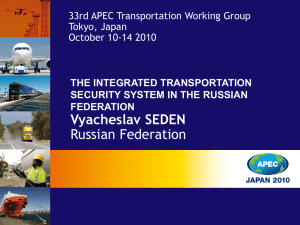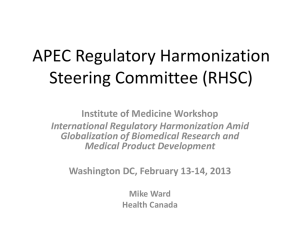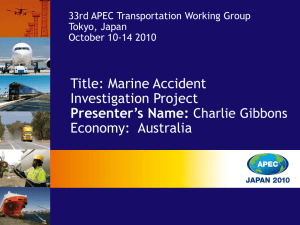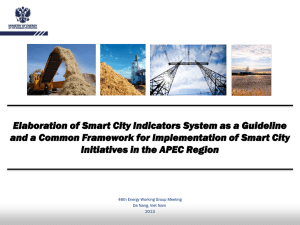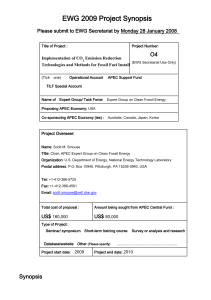WORD
advertisement
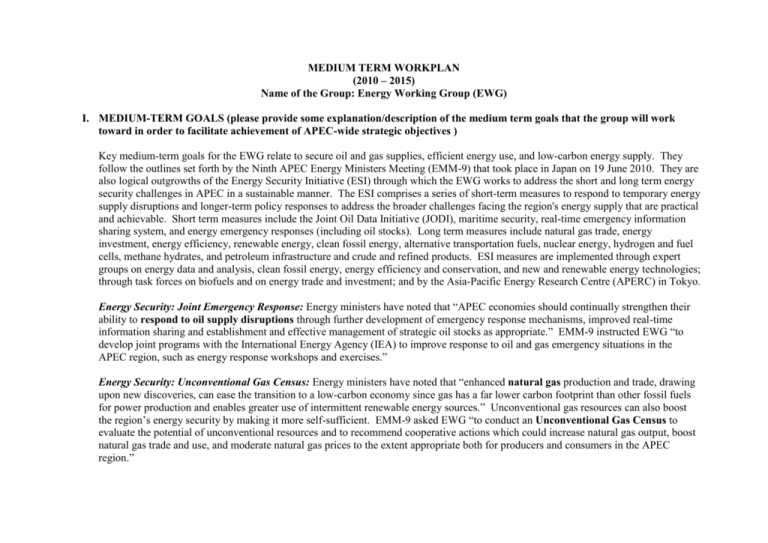
MEDIUM TERM WORKPLAN (2010 – 2015) Name of the Group: Energy Working Group (EWG) I. MEDIUM-TERM GOALS (please provide some explanation/description of the medium term goals that the group will work toward in order to facilitate achievement of APEC-wide strategic objectives ) Key medium-term goals for the EWG relate to secure oil and gas supplies, efficient energy use, and low-carbon energy supply. They follow the outlines set forth by the Ninth APEC Energy Ministers Meeting (EMM-9) that took place in Japan on 19 June 2010. They are also logical outgrowths of the Energy Security Initiative (ESI) through which the EWG works to address the short and long term energy security challenges in APEC in a sustainable manner. The ESI comprises a series of short-term measures to respond to temporary energy supply disruptions and longer-term policy responses to address the broader challenges facing the region's energy supply that are practical and achievable. Short term measures include the Joint Oil Data Initiative (JODI), maritime security, real-time emergency information sharing system, and energy emergency responses (including oil stocks). Long term measures include natural gas trade, energy investment, energy efficiency, renewable energy, clean fossil energy, alternative transportation fuels, nuclear energy, hydrogen and fuel cells, methane hydrates, and petroleum infrastructure and crude and refined products. ESI measures are implemented through expert groups on energy data and analysis, clean fossil energy, energy efficiency and conservation, and new and renewable energy technologies; through task forces on biofuels and on energy trade and investment; and by the Asia-Pacific Energy Research Centre (APERC) in Tokyo. Energy Security: Joint Emergency Response: Energy ministers have noted that “APEC economies should continually strengthen their ability to respond to oil supply disruptions through further development of emergency response mechanisms, improved real-time information sharing and establishment and effective management of strategic oil stocks as appropriate.” EMM-9 instructed EWG “to develop joint programs with the International Energy Agency (IEA) to improve response to oil and gas emergency situations in the APEC region, such as energy response workshops and exercises.” Energy Security: Unconventional Gas Census: Energy ministers have noted that “enhanced natural gas production and trade, drawing upon new discoveries, can ease the transition to a low-carbon economy since gas has a far lower carbon footprint than other fossil fuels for power production and enables greater use of intermittent renewable energy sources.” Unconventional gas resources can also boost the region’s energy security by making it more self-sufficient. EMM-9 asked EWG “to conduct an Unconventional Gas Census to evaluate the potential of unconventional resources and to recommend cooperative actions which could increase natural gas output, boost natural gas trade and use, and moderate natural gas prices to the extent appropriate both for producers and consumers in the APEC region.” 2 Energy Efficiency: Policies and Best Practices: EMM-9 instructed EWG “to keep promoting energy efficiency through the Peer Review on Energy Efficiency (PREE) and the Cooperative Energy Efficiency Design for Sustainability (CEEDS), and to consider follow-up efforts including capacity building activities, policy research support and processes to gauge the success of member economies’ efforts to implement the recommendations of these programs.” PREE is used to share information on policies and measures for improving energy efficiency, on how energy efficiency goals and action plans can be effectively formulated, on progress towards energy efficiency goals, and on how the implementation of action plans could be improved. CEEDS examines energy efficiency opportunities in key energy-consuming sectors; it has identified lighting, refrigerator-freezers, air conditioners, motors, and electronic standby as the five most important types of appliances of which to focus work on energy efficiency standards and testing methods. Energy Efficiency: Collaborative Assessments of Standards and Testing (CAST): Energy ministers have noted that “energy-efficient buildings and appliances are key to a sustainable future since the building sector accounts for two-fifths of energy use in the region. Net Zero Energy Buildings are being developed using energy-efficient appliances, components and systems. Trade and investment in energy efficient appliances can be encouraged through more harmonized standards and testing methods.” EMM-9 instructed EWG “to strengthen the APEC Energy Standards Information System (ESIS) and to conduct a series of Collaborative Assessments of Standards and Testing (CAST) for the energy-intensive appliances identified by CEEDS [Cooperative Energy Efficiency Design for Sustainability].” Energy Efficiency: Energy Intensity Reduction Assessment: Energy ministers have noted that “the aspirational energy intensity reduction goal agreed to by the APEC Leaders, to reduce the ratio of energy use to economic output by at least 25 percent from 2005 levels by 2030, will be far surpassed if recent trends continue.” EMM-9 instructed EWG “to assess the potential for reducing the energy intensity of economic output in APEC economies between 2005 and 2030, beyond the 25 percent aspirational goal.” Low-Carbon Energy: Nuclear Power Emissions Reduction Potential Study (NUPERPS): Energy ministers have noted that “A growing number of interested economies are using nuclear power to diversify their energy mix and limit carbon emissions. These economies are reaffirming their international commitment to safety, security and non-proliferation as the fundamental elements for the peaceful use of nuclear energy.” EMM instructed EWG “to undertake a Nuclear Power Emissions Reduction Potential Study (NUPERPS) on the potential for existing and planned nuclear power plants in interested APEC economies to reduce carbon emissions.” Low-Carbon Energy: Carbon Capture and Storage: Energy ministers have noted that “cost-effective technologies for carbon capture and storage (CCS) are essential to reducing carbon emissions from power generation within the many APEC economies that still rely on coal and other fossil fuels for a significant portion of their electricity generation” and that “clean coal technologies are available to make the use of coal more efficient and lower-emitting.” EMM-9 instructed EWG “to extend and reinforce its analysis of technology options for CCS and its dissemination of best practices for applying these technologies to new and existing power plants” and “to develop an initiative for deploying advanced clean coal technologies … to make coal-fired power plants more efficient.” 3 Low-Carbon Energy: APEC Smart Grid Initiative: Energy ministers have noted that “smart grid technologies, including advanced battery technologies for highly-efficient and cost-effective energy storage, can help to integrate intermittent renewable power sources and building control systems that let businesses and consumers use energy more efficiently, and they can also help to enhance the reliability of electricity supply, extend the useful life of power system components, and reduce system operating costs.” EMM-9 instructed EWG “to start an APEC Smart Grid Initiative (ASGI) to evaluate the potential of smart grids to support the integration of intermittent renewable energies and energy management approaches in buildings and industry.” Low-Carbon Energy: Low Carbon Model Town Project: Energy ministers noted that “introduction of low-carbon technologies in city planning to boost energy efficiency and reduce fossil energy use is vital to manage rapidly growing energy consumption in urban areas.” EMM-9 instructed EWG “to establish a Low-Carbon Model Town Task Force to “develop the concept of a Low Carbon Town, conduct feasibility studies to encourage creation of low-carbon communities in urban development plans, and share best practices for making such communities a reality.” Cross-Cutting: Fossil Fuel Subsidy Reduction: Energy ministers have reiterated their commitment to the 2009 Leaders' Declaration “to rationalize and phase out over the medium term fossil fuel subsidies that encourage wasteful consumption, while recognizing the importance of providing those in need with essential energy services.” EMM instructed EWG to work with IEA “to analyze remaining inefficient fossil fuel subsidies that encourage wasteful consumption with a view to their rationalization and phase out.” Cross-Cutting: Joint Meeting of High-Level Energy and Transport Officials: Energy ministers have noted that “fuel-efficient vehicles using lightweight materials and other advanced technologies can greatly reduce both oil consumption and carbon emissions” while “electric drive and other alternative fuel vehicles also provide a major opportunity to shift transport fuels from oil to other energy sources.” They have further noted plans for “the first-ever joint meeting of energy and transport high level officials in the United States in 2011.” In this light, EMM-9 instructed EWG “to continue assessing the resource potential for biofuels to displace petroleum-based fuels, the relative costs of biofuels, sustainable development practices for biofuels and strategies for expanding biofuels infrastructure, in cooperation with the Automotive Dialogue and the Transportation Working Group (TWG).” In addition, EMM-9 instructed EWG “to conduct a series of workshops on the potential fuel and carbon savings from electrification of the transport sector, energy efficient freight, transit-oriented development and other energy efficient transport strategies, in cooperation with the TWG.” 4 II. WORK PROGRAM GOALS/OBJECTIVES (PLEASE INDICATE THE ACTION ITEMS/SPECIFIC PROCESSES/ACTIVITIES EXPECTED OUTCOMES TIMEFRAME Phase 1: Emergency Response Training (ERT) in Paris on September 13-17, 2010. Two officials from each non-IEA APEC economy with responsibility for emergency preparedness for oil and/or natural gas disruptions can be nominated. The training will cover IEA oil and gas security policies and practices, national emergency preparedness policy, legislation and response structures, national emergency planning and preparation, outline of bilateral emergency preparedness programs between IEA and partner countries, data gathering for oil and gas markets in normal times and during emergencies, and data analysis to assess the impact of supply disruptions. Phase 2: Joint Emergency Response Exercise with IEA, APEC and ASEAN. (1) Prepare paper on resource surveys already underway. (2) Obtain expressions of interest from economies. (3) Convene group of interested APEC economies to elaborate a work program in which different economies agree to provide data on unconventional gas. (4) Assess impact of greater unconventional gas supply on APEC gas markets and prices. APEC economies that are not currently members of the International Energy Agency (IEA) can become more familiar with the emergency response procedures that IEA members follow. Closer coordination between APEC and IEA in the event of an oil emergency should result. Phase 1: September 13-17, 2010. APEC economies have a clearer sense of the size of the unconventional gas resource available, the potential impact on gas supply and prices, and the resulting potential for lower carbon emissions. (1) By 10/2010. ECOTECH PRIORITY WORKSTREAM THAT THEY SUPPORT) 1. Energy Security: Joint Emergency Response (Human Security) 2. Energy Security: Unconventional Gas Census (Environmentally Sound Growth) Phase 2: During first half of 2011. (2) EWG40 11/2010. (3) Draft program for consideration at EWG41 in 2011. (4) Assessment completed 2013. COOPERATING PARTY (MO/OTHER APEC FORA) International Energy Agency, Paris (IEA). Association of South East Asian Nations (ASEAN). Ministries in APEC economies with data on unconventional gas supplies. 5 3. Energy Efficiency: Policies and Best Practices (Environmentally Sound Growth) (1) Extend Peer Review of Energy Efficiency (PREE) to additional economies. (2) Extend Cooperative Energy Efficiency Design for Sustainability (CEEDS) to buildings sector and other sectors. (3) Complete studies of best practices for ensuring compliance with energy efficiency standards, installing energyefficient street lighting, encouraging green roofs and low-energy windows. Consider further studies on best practices for encouraging energyefficient appliances and buildings. 4. Energy Efficiency: Collaborative Assessments of Standards and Testing (CAST) (Environmentally Sound Growth) (1) Conduct energy standards mapping exercise for all major appliances in APEC. (2) Perform CAST for Light-Emitting Diodes. (3) Perform CAST for refrigerator-freezers. (4) Perform CAST for air conditioners. (5) Perform CAST for electronic standby. (6) Perform CAST for motors. 5. Energy Efficiency: Energy Intensity Reduction Assessment (Environmentally Sound Growth) 6. Low-Carbon Energy: Nuclear (1) More detailed analysis by APERC of how a 50 percent reduction in energy intensity might be achieved. (2) Peer review of the analysis by interested economies and experts; (3) Survey of energy intensity reduction goals adopted by APEC economies and what these would imply for the region. (1) Prepare paper outlining an analytic construct for assessing emissions reductions. (2) Form a group of interested APEC economies to participate in the study. (3) Interested economies provide data on current and potential nuclear installations. (4) Consultant reports on potential. Power Emissions Reduction Potential Study (Environmentally Sound Growth) (1) Clearer understanding of how APEC economies can achieve their energy efficiency goals. (2) Clearer understanding of key energy efficiency measures needed in each major energy consuming sector. (3) Sharing of best practices for bringing energy efficiency technologies to households and businesses in APEC. Improved understanding of gaps in APEC-ESIS and what needs to be done to strengthen APEC-ESIS. Clearer understanding of the standards and testing methods in place for key energy-intensive appliances, and the potential for bringing them into greater harmony. (1) Peru, Malaysia and Chinese Taipei in 2010. More later. Expert Group on Energy Efficiency and Conservation (EGEEC). (2) Buildings sector in 2010, other sectors TBD. (3) Complete ongoing studies in 2011 and newly starting studies in 2012. (1) Late 2010, initial report to EWG40. (2) Complete in 2011. (3) Complete in 2012 (4) Complete in 2013. (5) Complete in 2014. (6) Complete in 2015. Clearer understanding of the extent to which the energy intensity reduction goal for APEC can be strengthened, and specifically whether and by when it may reasonably be doubled to 50 percent. (1) Draft to EWG40 in 11/2010, revised report to EWG41. Improved understanding of the potential of nuclear power to contribute to greenhouse gas emissions reduction goals in APEC. (1) By 10/2010. (2) EWG-40 11/2010. (3) Workshops at EWG-41/42 (2011). (4) Consultant engaged 2011, report completed in 2012. (2) Early 2011. (3) During 2011. Subcommittee on Standards and Conformance (SCSC) of the Committee on Trade and Investment (CTI). Renewables and Efficiency Deployment Initiative of the Major Economies Forum. Expert Group on Energy Data and Analysis (EGEDA). Expert Group on Energy Efficiency and Conservation (EGEEC). Energy ministries in interested APEC economies. OECD Nuclear Energy Agency. 6 7. Low-Carbon Energy: Carbon Capture and Storage (Environmentally Sound Growth, Technologies for the Future) 8. Low-Carbon Energy: APEC Smart Grid Initiative (ASGI) (Environmentally Sound Growth, Technologies for the Future) 9. Low-Carbon Energy: Low Carbon Model Town Project (Environmentally Sound Growth, Technologies for the Future) 10. Cross-Cutting: Fossil Fuel Subsidy Reduction (Environmentally Sound Growth) (1) Continue an ongoing series of capacitybuilding workshops to help APEC economies assess the potential for uptake of CCS technologies. (2) Complete an assessment of the potential for storing CO2 co-produced with gas. (3) Complete a project on permitting issues associated with CO2 storage. (4) Undertake projects on the potential of advanced coal power cycles and technologies to make electricity generation from coal more efficient. (1) Complete report on the status and potential of smart grid technologies, within APEC economies, to enhance the use of renewable energy and of energyefficient buildings, appliances and equipment. Conduct a workshop to disseminate the findings of the report. (2) Consider further projects as needed in consultation with interested economies. (3) Integrate APEC Smart Grid Initiative with other smart grid efforts globally. (1) Form Low Carbon Model Town Task Force with interested economies; approve terms of reference. (2) Select low-carbon towns and communities to describe and analyze. (3) Perform analysis of best practices for integrating low-carbon solutions. Improved understanding of the potential of carbon capture and storage technologies – both precombustion for new coalfired power plants and postcombustion for existing plants – to limit greenhouse gas emissions in APEC. (1) Workshops in Malaysia, Thailand and Viet Nam could take place 2011-12. Improved understanding of the share of power that can practically be generated from renewable energy. (1) Early 2011. Better understanding of the mix of strategies that can be applied to reduce carbon emissions in urban areas, including strategies to improve the energy efficiency of buildings, power grids and transport systems. (1) Initial meeting held July 2010. Subsequent meetings back-toback with EWG. (1) Conduct project on best practices for Phasing Out Fossil Fuel Subsidies to Reduce Waste and Limit CO2 Emissions while Protecting the Poor. (2) Prepare progress report on steps taken by economies to phase out subsidies. Improved understanding of ways in which APEC economies have successfully moved to phase out fossil fuel subsidies while protecting the disadvantaged. (1) Obtain EWG endorsement around 9/2010, complete 2011. Improved understanding of the potential of smart grids to facilitate energy efficiency measures in smart buildings. (2) Late 2010. (3) During 2011-12. (4) During 2011-12. (2) Chair of Expert Group on New and Renewable Energy Technologies to recommend projects for 2011. (3) 2010 and onward. (2) 2010 and onward. (3) 2010 and onward. (2) Complete 2012. International Smart Grid Action Network (ISGAN) established by Clean Energy Ministerial and Major Economies Forum. Expert Group on New and Renewable Energy Technologies (EGNRET). 7 11. Cross-Cutting: Joint Meeting of High-Level Energy and Transport Officials (Environmentally Sound Growth) (1) Agree on themes for the meeting such as fuel-efficient vehicles, energy-efficient freight transport, transit-oriented development for livable communities, and alternative transport fuels. (2) Plan logistics of meeting for West Coast of the United States during 2011. (3) Complete projects on the energy and environmental benefits of transit-oriented development, intermodal freight (shifting from trucks to rail and ships and barges) and bus rapid transit in urban areas. (4) Complete projects on the resource potential of biofuels from algae, strategies for development of biofuel infrastructure, and biofuel economics. Improved understanding of the potential of different transportation strategies to reduce energy needs, oil imports and carbon emissions in APEC. Improved understanding of the potential of biofuels to sustainably displace petroleum-based fuels. Improved understanding by energy ministries of the potential of transport sector strategies and by transport ministries of the potential of energy sector strategies. (1) Present paper for discussion at EWG40 in 11/2010 and TPT-WG meeting. (2) Meeting to take place in 9/2011. (3) Prior to 9/2011. (4) Prior to 9/2011. Transportation Working Group. Biofuels Task Force.
